What Is a Subtraction Table in Math?
A subtraction table in math is a tabular representation of numbers arranged in rows and columns that enables us to determine the difference between two numbers only via observation rather than through calculation.
Subtraction is one of the four basic arithmetic operations in mathematics. Subtraction in math is a process of finding the difference between two numbers. Let’s quickly understand important terms in a subtraction equation.
- Minuend: The first number, the number from which another number will be subtracted
- Subtrahend: The second number, the number to be subtracted
Identifying the subtrahend and the minuend will help in reading and writing the subtraction table.
The subtraction table makes the process of subtraction easier. It is formed by arranging the numbers in rows and columns in a certain pattern.
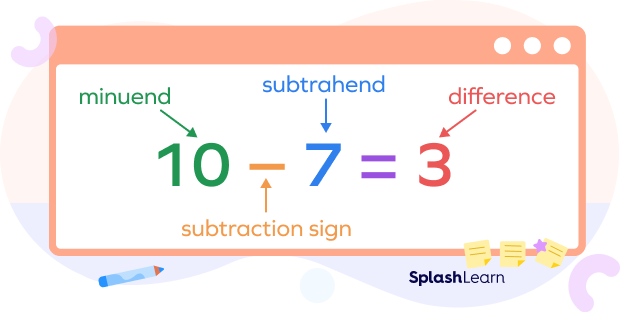
Recommended Games
Subtraction Table (Subtraction Chart)
Using the subtraction table, we can calculate the difference between two numbers without doing the calculation.
A basic subtraction chart takes you through the subtraction of numbers from 1 to 10.
Here, look for the first number in the top-most row and the second number in the first column.
| SUBTRACTION TABLE | ||||||||||||
| – | 12 | 11 | 10 | 9 | 8 | 7 | 6 | 5 | 4 | 3 | 2 | 1 |
| 1 | 11 | 10 | 9 | 8 | 7 | 6 | 5 | 4 | 3 | 2 | 1 | 0 |
| 2 | 10 | 9 | 8 | 7 | 6 | 5 | 4 | 3 | 2 | 1 | 0 | – 1 |
| 3 | 9 | 8 | 7 | 6 | 5 | 4 | 3 | 2 | 1 | 0 | – 1 | – 2 |
| 4 | 8 | 7 | 6 | 5 | 4 | 3 | 2 | 1 | 0 | – 1 | – 2 | – 3 |
| 5 | 7 | 6 | 5 | 4 | 3 | 2 | 1 | 0 | – 1 | – 2 | – 3 | – 4 |
| 6 | 6 | 5 | 4 | 3 | 2 | 1 | 0 | – 1 | – 2 | – 3 | – 4 | – 5 |
| 7 | 5 | 4 | 3 | 2 | 1 | 0 | – 1 | – 2 | – 3 | – 4 | – 5 | – 6 |
| 8 | 4 | 3 | 2 | 1 | 0 | – 1 | – 2 | – 3 | – 4 | – 5 | – 6 | – 7 |
| 9 | 3 | 2 | 1 | 0 | – 1 | – 2 | – 3 | – 4 | – 5 | – 6 | – 7 | – 8 |
| 10 | 2 | 1 | 0 | – 1 | – 2 | – 3 | – 4 | – 5 | – 6 | – 7 | – 8 | – 9 |
| 11 | 1 | 0 | – 1 | – 2 | – 3 | – 4 | – 5 | – 6 | – 7 | – 8 | – 9 | – 10 |
| 12 | 0 | – 1 | – 2 | – 3 | – 4 | – 5 | – 6 | – 7 | – 8 | – 9 | – 10 | – 11 |
Note:
Let’s try a different approach. We can also write the numbers from 0 to 12. Also, if we change the positions where the minuend and subtrahend are written in the table, we will look for the first number in the first column, and the second number in the top-row.
Take a look at the subtraction table build this way:
| Subtraction Table | |||||||||||||
| − | 0 | 1 | 2 | 3 | 4 | 5 | 6 | 7 | 8 | 9 | 10 | 11 | 12 |
| 0 | 0 | -1 | -2 | -3 | -4 | -5 | -6 | -7 | -8 | -9 | -10 | -11 | -12 |
| 1 | 1 | 0 | -1 | -2 | -3 | -4 | -5 | -6 | -7 | -8 | -9 | -10 | -11 |
| 2 | 2 | 1 | 0 | -1 | -2 | -3 | -4 | -5 | -6 | -7 | -8 | -9 | -10 |
| 3 | 3 | 2 | 1 | 0 | -1 | -2 | -3 | -4 | -5 | -6 | -7 | -8 | -9 |
| 4 | 4 | 3 | 2 | 1 | 0 | -1 | -2 | -3 | -4 | -5 | -6 | -7 | -8 |
| 5 | 5 | 4 | 3 | 2 | 1 | 0 | -1 | -2 | -3 | -4 | -5 | -6 | -7 |
| 6 | 6 | 5 | 4 | 3 | 2 | 1 | 0 | -1 | -2 | -3 | -4 | -5 | -6 |
| 7 | 7 | 6 | 5 | 4 | 3 | 2 | 1 | 0 | -1 | -2 | -3 | -4 | -5 |
| 8 | 8 | 7 | 6 | 5 | 4 | 3 | 2 | 1 | 0 | -1 | -2 | -3 | -4 |
| 9 | 9 | 8 | 7 | 6 | 5 | 4 | 3 | 2 | 1 | 0 | -1 | -2 | -3 |
| 10 | 10 | 9 | 8 | 7 | 6 | 5 | 4 | 3 | 2 | 1 | 0 | -1 | -2 |
Recommended Worksheets
How to Read a Subtraction Table Chart
Let’s take an example to understand how to read a subtraction table:
Ex: 6 – 9
Step 1: Look first for a number in the horizontal row. (Here, we need to find number 6 in the horizontal row)
Step 2: subtract from that number by selecting a number in the leftmost column (Here, we need to find number 9 in the FIRST column)
Step 3: Move along the row and down the column to find the cell where they meet. The number written in the cell is the answer. The answer here is -3.
How to Create a Subtraction Table
Let us write a subtraction table for 1 to 12.
Step 1: The first cell (top-left corner) shows the operation. So, we write the minus sign (-) here.
Step 2: The top-most row represents the minuend or the first number. This is where we look for the first number when we read the chart. Here, we write the numbers from 12 to 1. (You can also write the numbers from 1 to 12.)
Step 3: The first column (the left-most column) represents the subtrahend or the second number. This is where you search for the second number when you read the chart. Write the numbers from 1 to 12.
Step 4: Now, we fill in the cells based on the row and column it represents. We identify the minuend (the topmost number) and the subtrahend (the leftmost number) for the given cell. Subtract and write the difference in the given cell.
When filling the first row, the subtrahend (second number) is 1 (it stays the same for the entire row). We keep changing the minuend (the first number) using the top-most row and fill each cell accordingly.
Calculations for the first row:
12 – 1 = 11
11-1 = 10
10 – 1 = 9
9 – 1 = 8
8 – 1 = 7
7 – 1 = 6
6 – 1 = 5
5 – 1 = 4
4 – 1 = 3
3 -1 = 2
2 – 1 = 1
1 – 1 = 0
Thus, the entries of the first row are 11, 10, 9, 8, 7, 6, 5, 4, 3, 2, 1, 0.
In this way, we can create a subtraction table on our own. Here’s a subtraction table for numbers 1 to 10. You can try creating a subtraction table 1-100 for practice.
| SUBTRACTION TABLE | ||||||||||||
| – | 12 | 11 | 10 | 9 | 8 | 7 | 6 | 5 | 4 | 3 | 2 | 1 |
| 1 | 11 | 10 | 9 | 8 | 7 | 6 | 5 | 4 | 3 | 2 | 1 | 0 |
| 2 | 10 | 9 | 8 | 7 | 6 | 5 | 4 | 3 | 2 | 1 | 0 | – 1 |
| 3 | 9 | 8 | 7 | 6 | 5 | 4 | 3 | 2 | 1 | 0 | – 1 | – 2 |
| 4 | 8 | 7 | 6 | 5 | 4 | 3 | 2 | 1 | 0 | – 1 | – 2 | – 3 |
| 5 | 7 | 6 | 5 | 4 | 3 | 2 | 1 | 0 | – 1 | – 2 | – 3 | – 4 |
| 6 | 6 | 5 | 4 | 3 | 2 | 1 | 0 | – 1 | – 2 | – 3 | – 4 | – 5 |
| 7 | 5 | 4 | 3 | 2 | 1 | 0 | – 1 | – 2 | – 3 | – 4 | – 5 | – 6 |
| 8 | 4 | 3 | 2 | 1 | 0 | – 1 | – 2 | – 3 | – 4 | – 5 | – 6 | – 7 |
| 9 | 3 | 2 | 1 | 0 | – 1 | – 2 | – 3 | – 4 | – 5 | – 6 | – 7 | – 8 |
| 10 | 2 | 1 | 0 | – 1 | – 2 | – 3 | – 4 | – 5 | – 6 | – 7 | – 8 | – 9 |
| 11 | 1 | 0 | – 1 | – 2 | – 3 | – 4 | – 5 | – 6 | – 7 | – 8 | – 9 | – 10 |
| 12 | 0 | – 1 | – 2 | – 3 | – 4 | – 5 | – 6 | – 7 | – 8 | – 9 | – 10 | – 11 |
Subtraction Facts in a Subtraction Table
Let’s write the individual subtraction facts of 1-12 using the subtraction table.
| Subtraction Facts of 1 | Subtraction Facts for 2 | Subtraction Facts for 3 | Subtraction Facts for 4 | Subtraction Facts for 5 | Subtraction Facts for 6 |
| 1 – 1 = 0 | 1 – 2 = – 1 | 1 – 3 = – 2 | 1 – 4 = – 3 | 1 – 5 = – 4 | 1 – 6 = – 5 |
| 2 – 1 = 1 | 2 – 2 = 0 | 2 – 3 = – 1 | 2 – 4 = – 2 | 2 – 5 =- 3 | 2 – 6 = – 4 |
| 3 – 1 = 2 | 3 – 2 = 1 | 3 – 3 = 0 | 3 – 4 = – 1 | 3 – 5 = – 2 | 3 – 6 = – 3 |
| 4 – 1 = 3 | 4 – 2 = 2 | 4 – 3 = 1 | 4 – 4 = 0 | 4 – 5 = -1 | 4 – 6 = – 2 |
| 5 – 1 = 4 | 5 – 2 = 3 | 5 – 3 = 2 | 5 – 4 = 1 | 5 – 5 = 0 | 5 – 6 = – 1 |
| 6 – 1 = 5 | 6 – 2 = 4 | 6 – 3 = 3 | 6 – 4 = 2 | 6 – 5 = 1 | 6 – 6 = 0 |
| 7 – 1 = 6 | 7 – 2 = 5 | 7 – 3 = 4 | 7 – 4 = 3 | 7 – 5 = 2 | 7 – 6 = 1 |
| 8 – 1 = 7 | 8 – 2 = 6 | 8 – 3 = 5 | 8 – 4 = 4 | 8 – 5 = 3 | 8 – 6 = 2 |
| 9 -1 = 8 | 9 – 2 = 7 | 9 – 3 = 6 | 9 – 4 = 5 | 9 – 5 = 4 | 9 – 6 = 3 |
| 10 – 1 = 9 | 10 – 2 = 8 | 10 – 3 = 7 | 10 – 4 = 6 | 10 – 5 = 5 | 10 – 6 = 4 |
| 11 – 1 = 10 | 11 – 2 = 9 | 11 – 3 = 8 | 11 – 4 = 7 | 11 – 5 = 6 | 11 – 6 = 5 |
| 12 -1 = 11 | 12 – 2 = 10 | 12 – 3 = 9 | 12 – 4 = 8 | 12 – 5 = 7 | 12 – 6 = 6 |
| Subtraction Facts for 7 | Subtraction Facts for 8 | Subtraction Facts for 9 | Subtraction Facts for 10 | Subtraction Facts for 11 | Subtraction Facts for 12 |
| 1 – 7 = -6 | 1 – 8 = – 7 | 1 – 9 = – 8 | 1 – 10 = – 9 | 1- 11 = – 10 | 1- 12 = -11 |
| 2 – 7 =-5 | 2 – 8 = – 6 | 2 – 9 = – 7 | 2 – 10 = – 8 | 2 – 11 = – 9 | 2 – 12 = -10 |
| 3 – 7 = -4 | 3 – 8 = – 5 | 3 – 9 = – 6 | 3 – 10 = – 7 | 3 – 11 = – 8 | 3 – 12 = – 9 |
| 4 – 7 = – 3 | 4- 8 =- 4 | 4- 9 = -5 | 4-10 = – 6 | 4 – 11 = – 7 | 4 – 12 = -8 |
| 5 – 7 = -2 | 5 – 8 =- 3 | 5 -9 =- 4 | 5 – 10 = – 5 | 5 – 11 =-6 | 5 -12 = – 7 |
| 6 – 7 = – 1 | 6 – 8 = – 2 | 6 – 9 =-3 | 6- 10 = – 4 | 6- 11 =-5 | 6 – 12 = – 6 |
| 7 – 7 = 0 | 7- 8 = – 1 | 7 – 9 = -2 | 7 – 10 =- 3 | 7 – 11 = -4 | 7 – 12 = – 5 |
| 8 – 7 = 1 | 8 – 8 = 0 | 8 – 9 = – 1 | 8 -10 = -2 | 8 – 11 = – 3 | 8 – 12 = – 4 |
| 9 – 7 = 2 | 9 – 8 = 1 | 9 – 9 = 0 | 9 – 10 = – 1 | 9 – 11 = -2 | 9 – 12 = – 3 |
| 10 – 7 = 3 | 10 – 8 = 2 | 10 – 9 = 1 | 10 – 10 = 0 | 10 -11 = – 1 | 10 – 12 = -2 |
| 11 – 7 = 4 | 11 – 8 = 3 | 11 – 9 = 2 | 11 – 10 = 1 | 11 – 11 = 0 | 11 – 12 = – 1 |
| 12 – 7 = 5 | 12 – 8 = 4 | 12 – 9 = 3 | 12 – 10 = 2 | 12 – 11 = 1 | 12 -12 = 0 |
Patterns in the Subtraction Table
Observe the subtraction table closely and you will find many interesting patterns formed due to the properties of subtraction.
We know that subtracting the same number from itself results in 0. So, the diagonal elements from top-right to the bottom-left are 0.
Also, subtracting a greater number from a smaller number results in a negative number. Thus, the half triangular section below the diagonal has negative integers. The triangular section above the diagonal has positive integers.
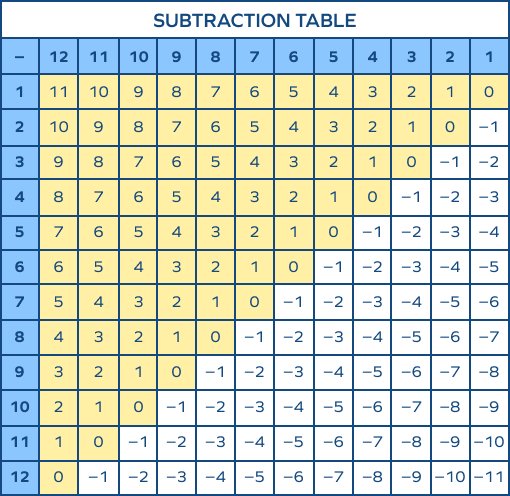
Facts about Subtraction Table
- Subtraction tables help with understanding the basics of subtraction, patterns in subtraction.
- Zero subtracted from any number gives the number itself.
- 1 subtracted from a number gives the predecessor of the number as the difference. For example: 150 – 1= 149
- The number from which the other number is to be subtracted is called the minuend. The number subtracted is called the subtrahend and the answer is called the difference.
- Minuend – Subtrahend = Difference
Conclusion
In this article, we have learnt about the subtraction table and how to read and write it. Now let’s solve some examples and practice problems to understand the concept better
Solved Examples on Subtraction Table
Example 1: Complete the following subtraction table by finding the missing numbers.
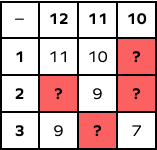
Solution:
10 – 1 = 9
12 – 2 = 10
10 – 2 = 8
11 – 3 = 8
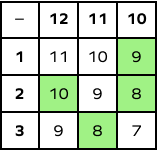
Example 2: How will you find the value of 10 – 2 by reading the subtraction table? Explain with steps.
Solution:
Step 1: Look for the first number in the horizontal row.
Step 2: Find the second number in the leftmost column.
Step 3: Move along the row and down the column to find where they meet. The number you arrive at the intersection is the answer. The answer here is 8.
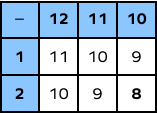
Example 3: Peter has 12 marbles. He gave 5 away to friends. How many marbles are left? Use a subtraction chart to solve the problem.
Solution:
Here, we have to find 12 – 5.
Let’s find it by using a subtraction chart.
Look first for number 12 in the horizontal row.
Now subtract from that number by selecting number 5 in the leftmost column.
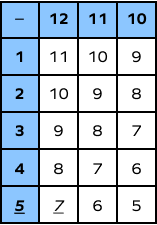
The row and column meet at the cell where we find the answer.
The answer here is 7.
Thus, Peter has 7 seashells left.
Practice Problems on Subtraction Table
Subtraction Table - Definition, Chart, Facts, Examples, FAQs
In the equation below, identify which number is the subtrahend. 50 - 8 = 42
A subtrahend is a number that is being subtracted from another number. In the equation 50 - 8 = 42, the subtrahend is 8.
Subtracting ____ from any number results in the same number.
Subtracting 0 from any number results in the same number.
The number from which we subtract another number is known as _____.
In subtraction, a minuend is the first number from which the other number is to be subtracted, and a subtrahend is the second number.
Which of the following patterns is visible in the subtraction table?
Subtracting a number from itself results in 0.
a - a = 0
Due to this, the diagonal from top-right corner to the bottom-left is filled with zeroes.
Frequently Asked Questions about Subtraction Table
Does the order of numbers matter in subtraction of real numbers?
In the case of subtraction, the order of factors is important because the subtraction is not commutative for real numbers.
What are the properties of subtraction ?
1. Not commutative: Changing the order of numbers affects the result.
2. Subtracting two natural numbers does not always result in a natural number (for example: 5- 8 = -3)
3. Subtracting 0 from any number gives the same number as a result because it is a neutral element.
What are subtraction table guidelines?
Understand the positions of the minuend and the subtrahend based on how the table is created (top-row and first column). The answer can be found where the column and row meet.
What are the ways to teach Subtraction?
Following are the ways to teach subtraction:
a) Use real life objects that you can find around the house.
b) Repeat everything twice, thrice and more ! This may seem a bit boring at first, but it is really necessary.
c) Use a ton of visual examples so that children can remember everything more easily.
In subtraction, what happens when the subtrahend and minuend are equal to each other?
When the subtrahend and minuend are equal, the resulting answer is zero.
In subtraction, is it possible that the subtrahend is larger than the minuend?
Yes, either one of the minuends or the subtrahend can be larger than the other in an equation. The placement of both numbers will ultimately impact the difference.
What are subtraction facts?
Subtraction facts are simple numerical expressions stating the difference between two numbers. For example, 9 – 2 = 7 and 8 – 2 = 6 are examples of subtraction facts of 2.




































